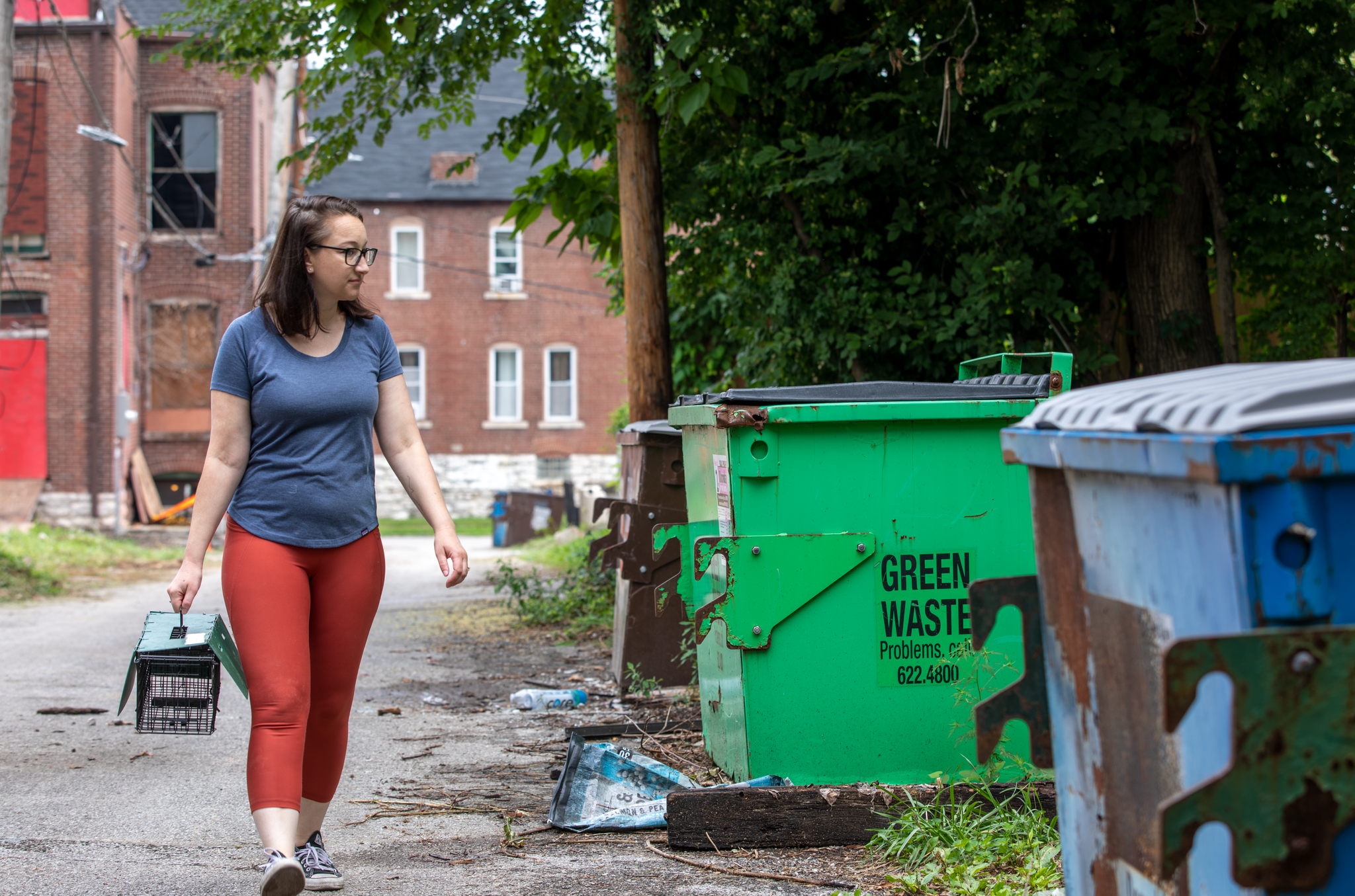Elizabeth Carlen and two of her undergraduate researchers work to bring science outside the walls of WashU.
Diving into Diet

“Squirrels will eat anything,” Jenny Mann, a junior Biology major at Washington University in St. Louis, tells me. She grabs her phone, pulling up a picture she took of a squirrel eating a slice of pizza in a tree. I’m in McDonnell Hall sitting with Mann, Wissal Boudaoud (another junior Biology major), and Elizabeth Carlen—a Living Earth Collaborative Biodiversity Postdoctoral Fellow in Jonathan Losos’ lab at WashU. Carlen mentors these undergraduate students in addition to conducting her own research here.
Mann’s project involves ascertaining the diet of these squirrels through the carbon and nitrogen ratios in their fur. These particular squirrels will snack no more: they are predominantly roadkill from here in St. Louis. “One of the squirrels in there is in really good condition,” Mann says, referring to the larger lab space across the hall from the office. “It’s pretty cute.” She takes me over and starts pulling little furry bodies out of Ziploc bags from where they’re stored in the freezer, pointing out color variations and broken claws like she’s been doing it her whole life. Her workspace is organized. “I have a system,” she says. She is unbelievably cool. With Carlen’s guidance, Mann does everything from specimen preparation to DNA extraction.
This research on Eastern Gray Squirrels is just one part of understanding the effects of environmental racism in both the animal and human communities in St. Louis. The fur analysis will help answer questions about how these squirrels are interacting with urban landscapes, mainly, are they eating human food?
Carlen is no stranger to the animals that everyone else overlooks. Her previous research on pigeons has been written about in places like The New York Times and The Atlantic. She knows that even small things can have a big impact.
The Power of a Name
Wissal Boudaoud has a color-coded spreadsheet in front of her on the computer. It’s beautiful, if you’re into that sort of thing, which I am. Her research is focused on mammalian etymology. She’s documenting thousands of latinized, scientific names, but more importantly, where those names come from, who these animals are named after. Historically, the answer seems to be “white men.” Boudaoud, who also has a minor in writing, is hoping to eventually publish this as a research manuscript.

“What are we choosing to honor?” Carlen asks. “We want to convey something in the meaning of these names.” The best names, they tell me, are the ones that suggest something about where the animal lives or how it behaves or what it looks like. Boudaoud and Carlen are hoping that this research sheds light on the importance of names across broader scientific fields.
So the work Boudaoud is doing in this little office will have an impact on a much larger scale. That seems to be Carlen’s goal, to have her work exist outside of a bubble, whether that means collecting extra morphometric data for other universities to use or trying to shift the scientific naming narrative. This research reaches beyond the walls of WashU.
The name project is relatively new, having only started in the spring of 2023. Despite the newness, Boudaoud is fully invested in the work. She answers all my questions like an expert, a testament to her dedication.
“It’s their space too,” Carlen says, in reference to these undergrads working alongside her in the office. She manages seven in total. They’re comfortable in the lab. They want to be here. They clear their Friday schedules so they can go out in the field. They have clearly found, as Carlen says, “their sparks.”
A Different Kind of Fieldwork
The following Friday, Mann, Carlen, and I spend the morning driving around North St. Louis setting traps. The squirrels we catch will be examined right there in the field and then immediately released.
Carlen knows where the squirrels are. She can turn down an alleyway, glance at some gnaw marks on a trash bin, and know they’re there before I can even spot a flash of gray fur. Mann, who Carlen sometimes refers to as a miniature version of herself, is getting good at it too. They tell me about what kind of trees squirrels like (lots of branches) and where the traps will probably be most successful (by the garbage).

“We’re weird,” Carlen cheerfully says to a man in his backyard who is watching us with a bit of confusion. “We’re collecting data on squirrels.” We’re all standing in an alleyway sandwiched between two rows of houses. It’s where the trash bins are. And where the squirrels are. The man suggests the best places to set our traps.
“People want to be involved in the research,” Carlen tells me as she grabs some organic walnuts from a bag. Bait. “I have people telling me about the roadkill they find.” What she’s saying is that this is a community effort—from the undergrads to the neighbors. (There’s even a link on her website if you’re interested in helping out.) Getting people involved is how you get them excited, how you get them to care.
The squirrels we’re looking at today will serve Mann’s research about diet, but also Carlen’s research about population genetics. This DNA data will be combined with morphological data and landscape metrics to identify patterns of squirrel movement across St. Louis, telling us more about how the city is impacting the natural world.
Boudaoud joins us in the afternoon for the actual data collection. I watch as the three of them open the traps, take the measurements, collect the fur, release the squirrels…it’s clear how much these students have grown, in both skill and confidence, under Carlen’s mentorship.
“You have it down to a science,” I say.
“It is a science,” Carlen responds, smiling, but all of us know it’s something more than that.




